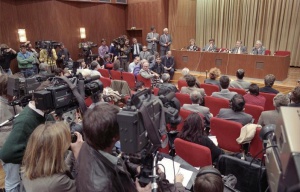 I am taking dancing lessons in preparation for my daughter’s wedding next month, and one of the things I’ve noticed is that when the instructor shows me a new step, it looks simple. But when I try it, I can’t get it until I step through it a few times.
I am taking dancing lessons in preparation for my daughter’s wedding next month, and one of the things I’ve noticed is that when the instructor shows me a new step, it looks simple. But when I try it, I can’t get it until I step through it a few times.
According to training lore, I guess that makes me a kinesthetic learner. But if you consider the corollary to that statement, I suppose an auditory learner would be able to pick up the steps simply by listening to the following instructions: “move your left foot about twelve inches to the side, then bring your right foot to meet it; next, advance your left foot forward a bit. But be sure to make the first two steps quick, and the third step slow…”
I had an opportunity recently to sit through a facilitation skills class put on by a major training company, and I was astonished to find that they still teach the idea that facilitators should tailor their techniques to the styles of their learners. One would think that they would have buried this myth long ago, since there is no scientific evidence to support it. Learning theorist Richard Mayer illustrated the weakness of the idea with one experiment that I’ve written about, and another famous example in the literature is described in John Medina’s book, Brain Rules. He describes a study in which expert wine tasters—about as kinesthetic as you can get—were completely fooled into describing white wines with the language reserved to reds, merely through the addition of food coloring. Maybe they were closet visual learners, but I doubt it.
Even if it were true, I can’t see how the instructor would actually change anything—they’d have to first, figure out how to quickly identify the style of each individual, and second, say or show everything three different ways to make sure everyone gets it.
But there actually is one way the idea applies, and dancing lessons offer a clue. It depends on the subject matter and the task. One can understand complicated verbal directions for navigating in a strange town, but a map is much more efficient. It’s possible to learn how to dance by watching others on YouTube, but trying the steps is much more efficient. You can memorize the words to a song by reading them on paper, but hearing them is much more efficient.
Why should this be important to you? Because if you believe the myth, it just becomes another useful excuse for why you didn’t learn something. The world is not going to accommodate itself to your imagined strengths and weaknesses.
You hear what I’m saying? Do you get the picture? Can you feel me?
When you shop for a new car, you are probably not an automotive expert who knows all about the fundamentals of a vehicle’s quality: all the hidden things such as the engine, transmission, steering and brakes. How well will the vehicle perform, how reliable will it be, etc. But you can see the car’s finish, and you can slam a door to listen for that satisfying sound that tells you it’s solid and precisely machined. On the other hand, if you notice a blemish in the paint, it’s likely that no number of impeccable reviews would overcome your impression of poor quality. Although you might not admit it, those little quality signals can have a huge influence on your final decision.
Let’s carry over the idea to B2B sales presentations. Suppose you’re a high-level decision maker for a very expensive and technically complex investment facing your company. You have people who have done the detailed work of gathering information and winnowing out potential vendors, but now it’s your responsibility to make the final choice, and you are about to listen to each salesperson or selling team make their pitch. What will you use to decide?
In my book Strategic Sales Presentations, I shared the story of the PR firm that presented to the senior leadership of a large West Coast technology company. The presenting team did such a marvelous job during the presentation that they last person was barely out the door when the CEO turned to my friend and said, “Hire them.”
That CEO had made a decision based on the substitution principle. Daniel Kahneman tells us in his book, Thinking Fast and Slow, that our minds like to take shortcuts, so when we are faced with a highly complicated and difficult decision, we often substitute an easier question for the harder one:
“Whether you state them or not, you often have answers to questions that you do not completely understand, relying on evidence that you can neither explain nor defend.”
Any time you make a buying decision, you are essentially making a probability judgment: that the decision you make has the highest likelihood of making you better off while avoiding additional problems. Probability judgments are always hard, and even more so when they are based on multiple factors that are outside your area of expertise—and the larger and more important the deal, the greater the chance that the key deciders will be generalists. So, it behooves you to get the quality signals just right.
This is in no way a repudiation of my cherished principle that content is king. You absolutely must have a strong and relevant solution to succeed in the long run—a professional and smooth presentation won’t sell a bad solution. But unfortunately good solutions can easily be derailed by bad presentations. Your company may have billions of dollars of assets, thousands of highly competent employees, and state of the art technology, but the decision makers who count can’t see all those things. All they can see is you. You are a signal of quality.
What signals do potential customers look for, albeit unconsciously?
- Do you have my best interests at heart? Do you have a thorough grasp of my business and personal goals; do you understand the problems and opportunities that your offering impacts; what will it be like to work with you; do you sound honest?
- Are you competent? Are you prepared, efficient and organized; if I scratch beneath the surface of your presentation, do you have depth of knowledge; do you sound confident in what you’re talking about?
I did not receive a newspaper this morning, which was inconvenient. But placing the call to register a complaint was worse. I knew what I wanted to hear, but I had to endure a (to my mind) convoluted series of questions and choices before I finally received the verdict: “We are not able to deliver your paper today.” I was utterly unable to reach a live person.
What does this have to do with anything? It reminded me of many sales presentations I’ve seen. The presenter is chained to a long and mostly irrelevant slide presentation. Maybe they put it together themselves and are proud of every animation, bullet point or slick picture. Worse, it might have been something produced by their marketing department to tell “their story”, and which they’re not allowed to deviate from.
It reminds me of the time a guy came to my house to sell me an alarm system. He had one of those old-fashioned notebooks with slick graphics that he tried to force me to listen to page by page. I told him to speed it up and just answer my questions, and he said that if he did that, I would not buy—because I had to understand everything to make the right decision. He was right about one thing—I did not buy, because it was more fun to tell him to pack up his notebook and leave.
Is your presentation an algorithm or a hypothesis?
These types of presentations are like algorithms, where a pre-defined process, followed exactly, should lead to a pre-determined result. There are two problems with this: sometimes things happen during the presentation which throw the process off track, and even when everything proceeds properly, the audience may feel like they’ve been manipulated, like objects passing through an assembly line.
Think of your prepared presentation as a hypothesis, and your delivery as an experiment. Your hypothesis is about what this particular customer needs to hear at this particular time to make a decision that will be of particular benefit to them. Like any hypothesis, it needs to be validated, so the presentation itself is an experiment. If you’ve done the right kind of work, the hypothesis should be fairly close to the truth, but you will not know for sure until you’ve gathered data in the form of reactions, questions, and objections from the audience, and made adjustments accordingly.
You may end up validating your hypothesis completely; in some cases you will mutually agree that the hypothesis was wrong; the most likely result is that there will be some audience-driven adjustments which will make the presentation and the solution better. Regardless of how it turns out, people will feel like they were heard, respected, and empowered to make the best decision for themselves.
The irony is that the surest path to this level of flexibility and responsiveness in a presentation is thorough preparation. Preparation will make you learn your message and your material so that you can have the confidence to deviate, without being worried that you’ll lose your place on the slides. It will enable you to look your listeners in the eyes while speaking, rather than reading your words off the screen behind you. It will give you the depth to answer drill-down questions. In short, preparation will give you the freedom to be yourself, and give your audience the gift of speaking to a live person.
I harped last week about the critical importance of careful preparation and anticipation for the Question and Answer period after your presentation. In case that did not convince you, I’d like to introduce you to Gunter Schabowski, who made one of the most consequential gaffes in the history of Q&A.
Gunter was a member of the East German politburo who became its principal spokesperson in 1989, as Gorbachev’s reforms began inspiring eastern Europeans to test the bonds that held them in the Soviet orbit. East Germans in particular were chafing to open the borders between themselves and West Germany.
In response, the politburo had decided to open the borders under special conditions and proper permissions, in a meeting which Schabowski did not attend. He was handed a note to that effect just before his press conference on November 9, 1989. What the note did not say was that the rules would not apply to the West Berlin crossings, and that they would not take effect until the following day, to allow time to communicate the rules to the border guards.
In the press conference, Schabowski read the note out loud when he was asked (probably by Tom Brokaw) when the rules would take effect, Schabowski said: “As far as I know, effective immediately—without delay.”
Schabowski’s answer aired on West German television at 7:17pm, and thousands of East Germans rushed to the gates. As the news covered the growing crowds, more and more East Germans flocked to the border crossings. Border guards became increasingly concerned as the crowds swelled, but no one would take the responsibility to order them to fire on the crowds. Finally, at about 11:30pm, the guards simply opened the gates—and the East German regime effectively died at that moment.
What does this incident teach us about fielding questions after a presentation? The obvious lesson is that you should prepare carefully and do your best to anticipate how the audience will react to your message and what their legitimate concerns and questions might be—especially when so much is at stake.
But, (and here I’m trying to anticipate your question), the pace of events precludes careful preparation; real life does not always afford the leisure to ponder all the possible questions and objections. Sometimes you have no choice but to speak before you’re ready. That’s true, which is why sometimes your best answer is also the most honest one: “I don’t know, but I’ll find out and get back to you.”
Chances are that you will never face a Q&A where you could lose your reputation, your job and your country because of one careless answer—but are you willing to take that chance?





